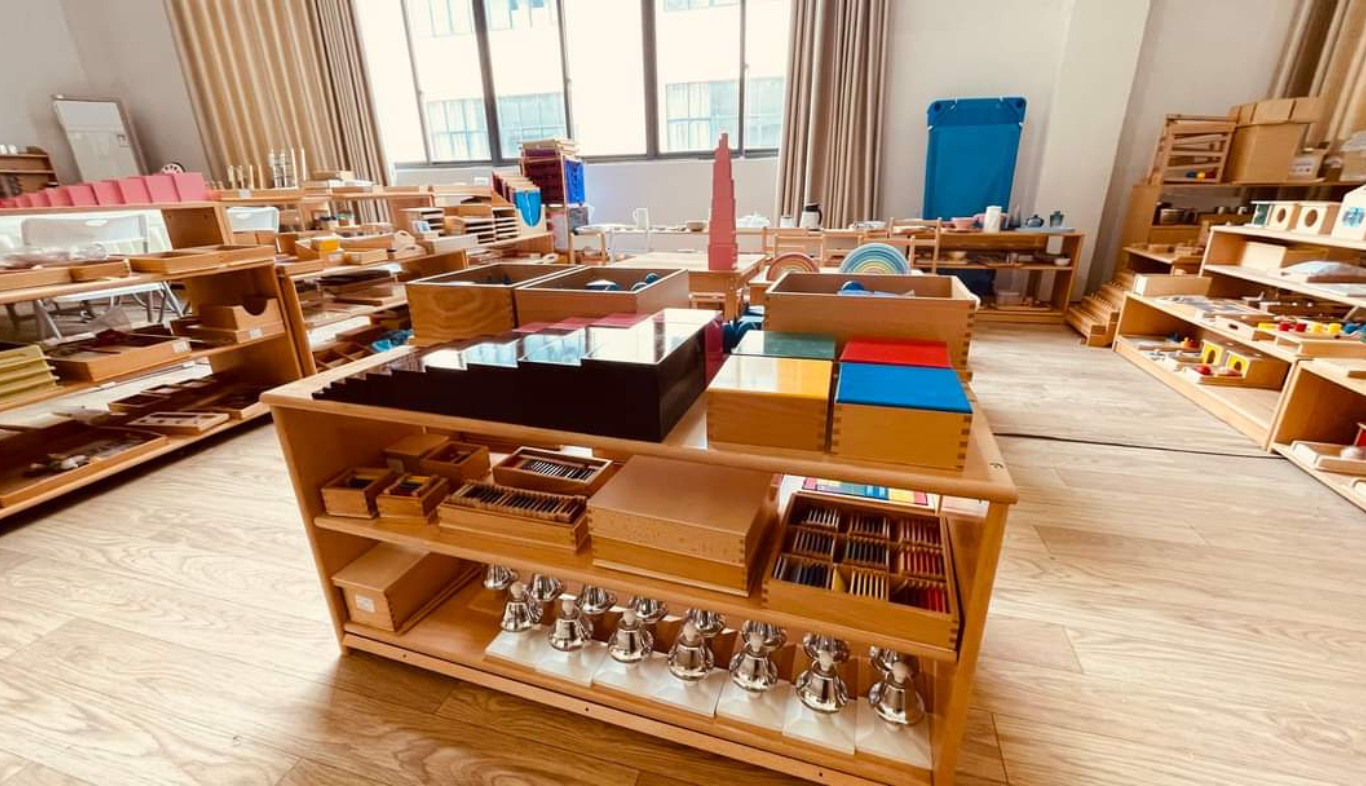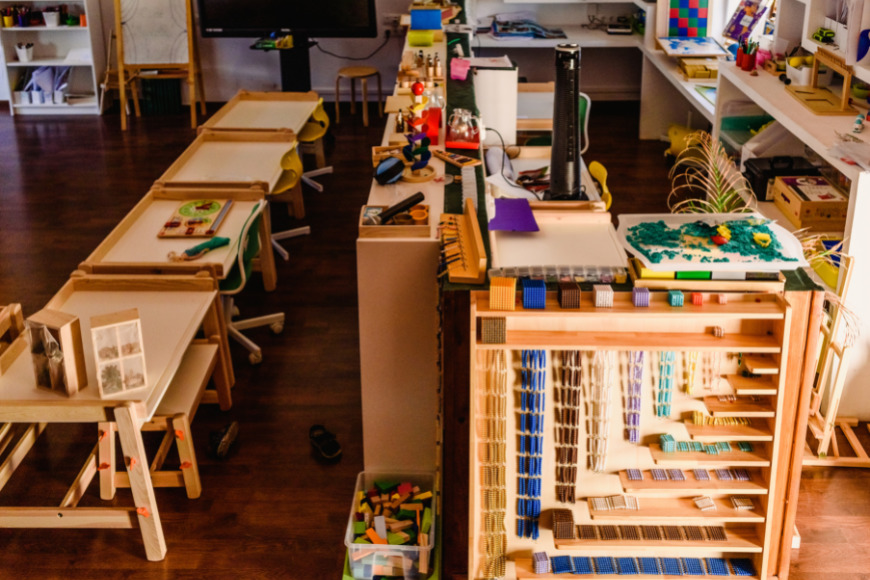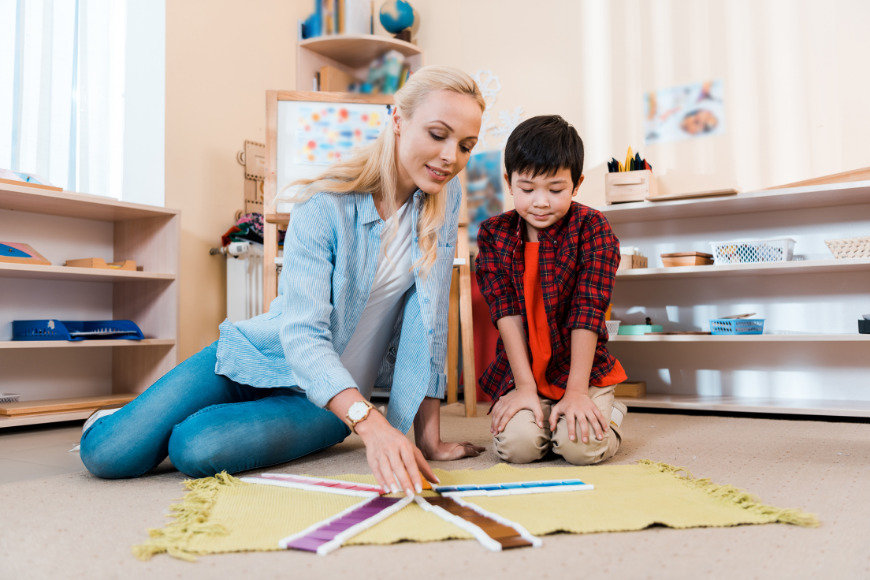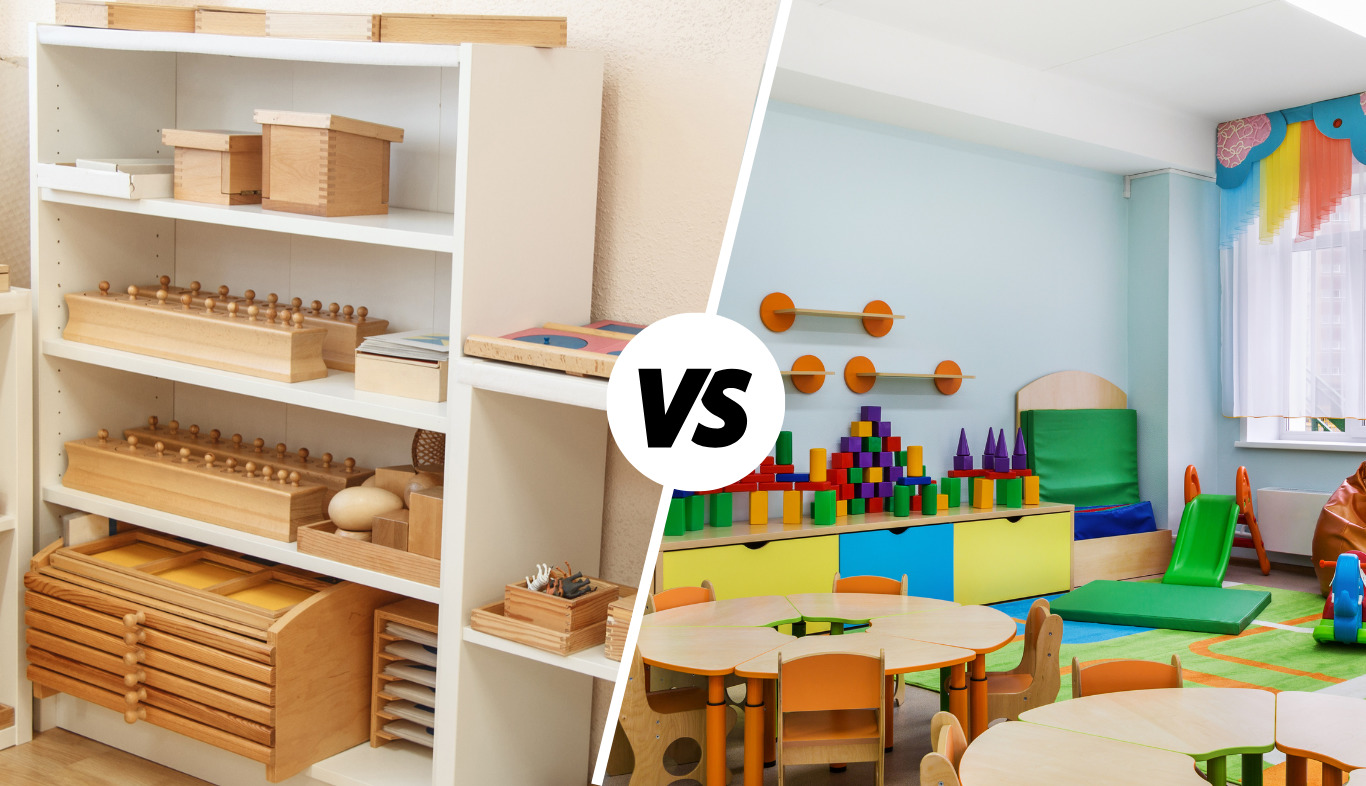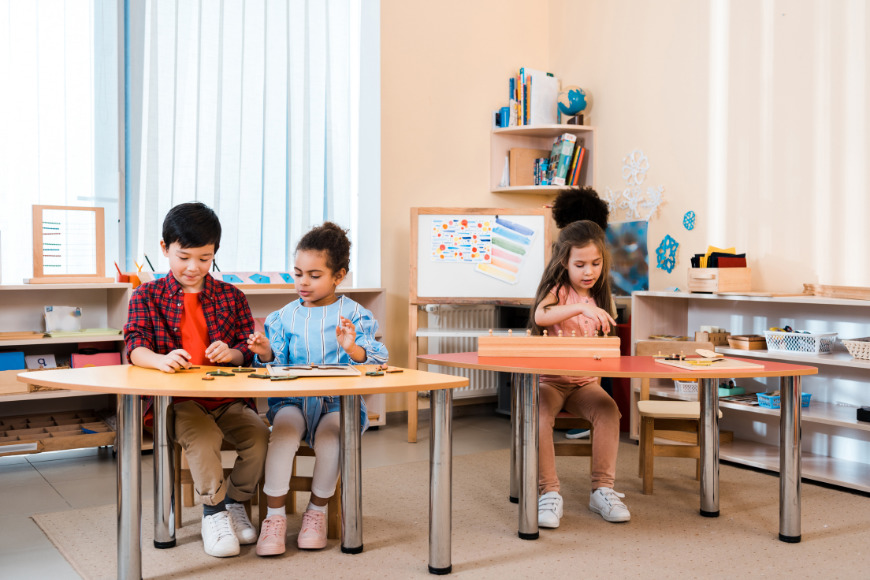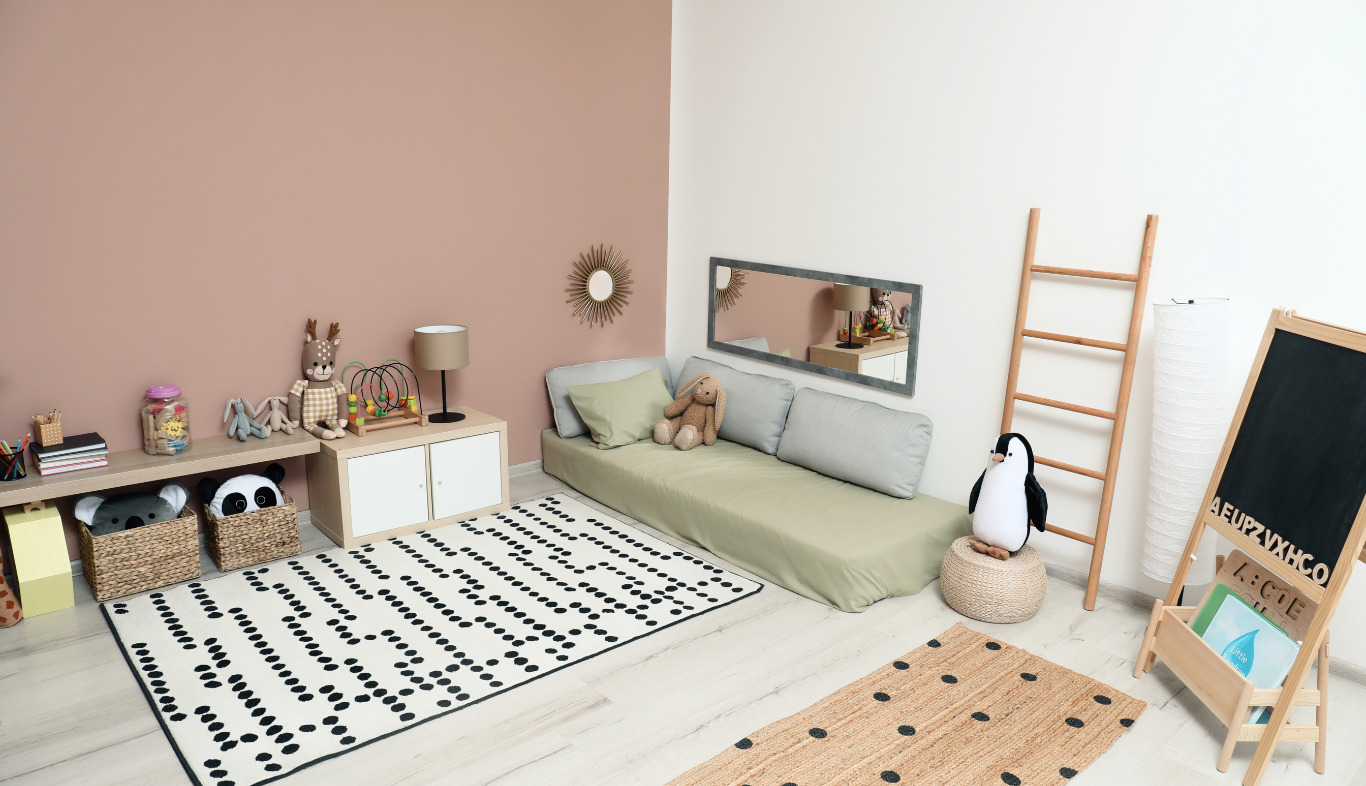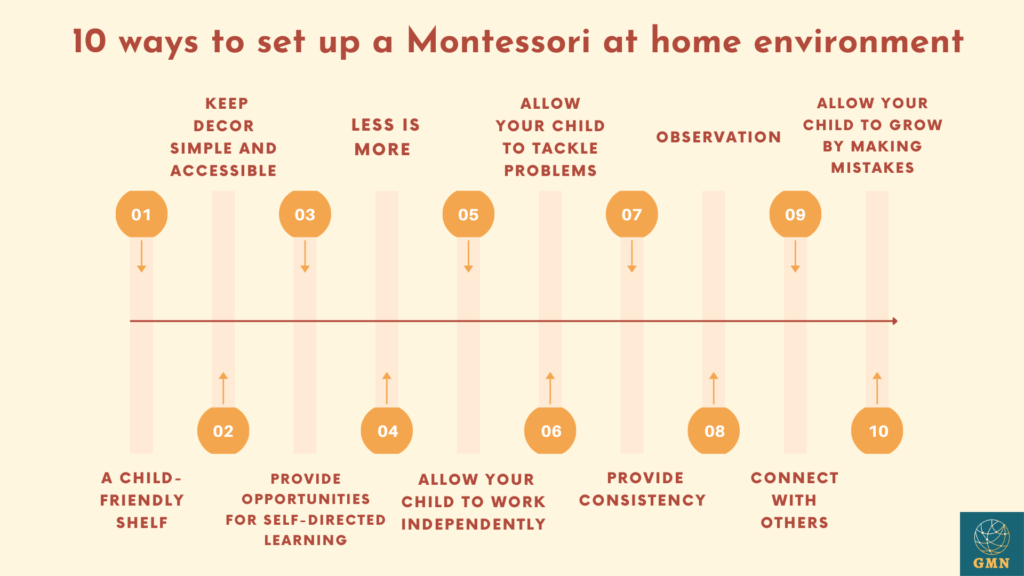As parents, we are always worried when choosing an education system for our children. But, have you ever heard of an education system that emphasizes the learning process instead of age? Or even if you have been, do you know what a Montessori curriculum looks like?
Well, the Montessori method of education is renowned for its learning process. It focuses on the rate and speed at which a child can acquire a skill before moving on to another skill.
Montessori is a learner-centered education and focuses on the individual and their developmental needs. In general, Montessori education is based on three principles:
- The development of independence, self-control, and self-discovery.
- Respect for the child’s culture, environment, language, and values.
- The natural unfolding of a child’s interest in a prepared environment.
According to the Montessori method of education, children learn best when they are allowed to explore, experiment, and take risks on their own and with their peers. As a result, the Montessori classroom, or environment, is carefully prepared in a way that responds to a child’s need to learn and grow. It is done by exposing them to materials and experiences that stimulate intelligence and promote physical and psychological development. Let us take a closer look at the Montessori curriculum.
Key Terms Of Montessori Curriculum
A Montessori curriculum is a sequence of materials, activities, and experiences that provide children the opportunity to develop their natural love for learning. It is unique and progressive as the focus is on concrete and experiential learning.
“In addition to the use of each material being highly structured, the overarching Montessori curriculum is also tightly structured. Materials within a curriculum area are presented in a hierarchical sequence, and there is a complex web of interrelationships with materials in different areas of the curriculum. As far as I know, no other single educational curriculum comes close to the Montessori curriculum in terms of its levels of depth, breadth, and interrelationship across time and topic.” – Dr. Angeline S. Lillard. in An Answer to the Crisis in Education.
The Montessori Curriculum Includes
- classroom organization
- child-arranged work (learning by doing)
- individual work (learning by self)
- group work and discussion
- practical life activities
- sensory exploration and movement
- classic art and literature
Montessori methods of education encourage children to explore the world in a structured learning environment that fosters their need to learn and grow by exposing them to materials and experiences that stimulate intelligence and promote physical and psychological development.
Montessori educators introduce concepts – like reading, writing, geometry, and mathematics – using learning materials, allowing children to learn at their own pace. Lessons are brief, concise, and direct, with the goal of increasing the child’s independence and love for learning.
Multi-age Classrooms
Montessori schools have multi-age group classrooms arranged in the following manner:
- Infant: 0-18 months
- Toddler:1-3 years
- Early Childhood: 3-6 years
- Lower Elementary: 6-9 years
- Upper Elementary: 9-12 years
- Secondary: 12-18 years of age
Montessori Curriculum and Learning Environment
The American Montessori Society (AMS) and the Association Montessori Internationale (AMI) are two organizations that provide guidance for structuring the Montessori curriculum and schools, keeping all the areas of a child’s development in mind.
Here is a glimpse of how the curriculum is structured in the Montessori classrooms:
Montessori Curriculum for Toddler Level Children (0-3 years or Pre-Nursery)
Montessori curriculum for toddlers is based on 6 integrated areas of development, i.e. sensory & perceptual, physical, cognitive, gross motor & fine motor skills, self-care & personal development skills, and social & emotional skills.
Keeping the areas of development in mind, the toddler classroom must include a progressive environment that promotes freedom of movement, integrates daily routines, and provides experiences that foster a child’s growth and independence. Thus, engaging children in daily activities based on their needs, capabilities, and interests.
Montessori Curriculum for Primary Level Children (3-6 years or Kindergarten)
The Early Childhood curriculum integrates the core areas of Practical Life, Sensorial activities, Math, Spoken Language, Reading and writing, Peace and Cosmic Education, and Cultural Subjects.
The learning environment is child-centered, which promotes self-efficacy, independence, refinement of their movements, sensory perceptions, language, and cognitive development. Many opportunities are provided for children to pursue their own interests, choose their own activities, develop their concentration abilities, and engage at their own pace in their developing abilities in reason, imagination, and sociability.
Montessori Curriculum for Elementary Level Children (6-12 years)
At the age of 6-12 years, children enter a new period of development that is
- Transitioned from concrete to abstract thinking,
- More Social
- More creative thinking and problem solver
- Have an interest in fairness, social justice, and compassion
The Elementary curriculum builds an in-depth study of the world and how it works. It is interdisciplinary and integrates the core subjects of Mathematics (including geometry and algebra), biological and physical science, technology, language arts & literature, history, geography, geology, anthropology, physical and political world, civics, economics, art, music & other forms of artistic expression, additional/world Language, cosmic education and physical education.
This curriculum helps children to foster a feeling of connectedness to humanity and encourages children’s natural desire to contribute to the world. It also allows them to explore their interests and acquire mastery of basic skills and knowledge.
Elementary classrooms are child-centered and provide a learning environment that promotes organizational and time-management skills, conflict resolution skills, concentration, independence, cooperation, and collaboration.
Montessori Curriculum for Secondary Level Children (12-18 years)
Children in the age group of 12-18 years are at the threshold of reaching adulthood. As a result, the environment should reflect the full spectrum of adult life and provide opportunities for not only pursuing academic interests but also participating in actual adult practical work in an environment closer to real society. Thus, the secondary-level curriculum in Montessori focuses on 4 developmental stages: physical, emotional, social, and cognitive.
Besides the core curriculum areas of math, language arts, social studies, and science, the Secondary Curriculum (sometimes called Erdkinder) includes world languages, creative arts, health and fitness, fieldwork (like apprenticeships), community service, and career exploration.
The curriculum prepares children for post-secondary education or careers through self-construction, extensive self-reflection, and opportunities for leadership and personal responsibility.
Children in secondary classrooms are involved in complex projects that include research and presentations to demonstrate mastery of concepts. It promotes time management, organization, independent decision-making, problem-solving, community building, and the application of learning.
How Does the Montessori Curriculum Differ from the Conventional School Curriculum?
Ideology
Montessori classroom is always focused on independence. While the curriculum provides a classroom with structure. Its prime focus is on children (individuals) and should be given the freedom to choose their own activities and focus on learning in their own way. This approach not only promotes independence in children but also instills a mature outlook on life and accomplishing problems.
Children are allowed to move at their own pace and move on from one skill if they are ready (regardless of age). That’s why classrooms with mixed- age are promoted. Teachers (or guides) will observe and help and direct where needed, and will not interfere with a child’s learning process.
Unlike conventional education, the Montessori curriculum does not encourage the memorization of information/lessons. The Montessori curriculum emphasizes early childhood development rather than focusing on the same things or learning them in the same way.
Focus
The Montessori curriculum is a child-centered, hands-on approach to learning. It is based on the principle that children are naturally curious and eager to learn. The curriculum offers opportunities for children to focus on developing independence, correcting their errors, and respect for others & the environment. It also fosters creativity in children by giving them opportunities to explore and experiment with materials in a supportive environment.
Whereas, conventional school curriculum focuses on teaching academic subjects through lectures, textbooks, worksheets, homework assignments, etc. It may lead to boredom among students who do not enjoy those subjects or who don’t learn well from those methods of instruction. It is more teacher-directed and focuses on developing pre-reading, pre-writing, mathematical, and language arts skills.
Subjects
In a Montessori school, subjects are divided into 5 core subjects: language, practical life, mathematics, culture, and sensorial. Each area of study includes educational materials that increase in complexity as they achieve one skill. Children progress through the Montessori Curriculum at their own pace, based on their stage of development and interests. Lessons are short, concise, direct, and aimed at enhancing the child’s self-worth.
In conventional schools, subjects are literature, science, social studies, arts, mathematics, and language. Each has 10-12 pre-defined lessons which change every year. All the children learn at the same pace and speed.
Evaluation
In a Montessori school, educators assess children using formative observations that complement a carefully prepared classroom environment. This observation happens during a session or when a child is engaged in an activity. They check if a child is on the right path for their overall development.
Whereas in conventional preschool, the assessment is based on tests and exams where children are provided with a questionnaire to answer, then grades are provided based on the answers they have written and the teacher’s knowledge.
How do Montessori Education Benefit Children?
For parents who are not sure which type of education is best for their children, this section helps them to decide. It will also help them understand how the Montessori curriculum will benefit their child’s development needs. Children absorb everything until the age of 6 years because it is a time of exploration. This is where the Montessori curriculum stands out.
5 Benefits of the Montessori Curriculum
- The curriculum is designed to foster self-confidence and independence in children by giving them the freedom to explore their environment and learn through experimentation without the fear of failure. Thus, making it essential for developing minds.
- It assists children in developing critical thinking abilities, problem-solving skills, and creative thinking.
- It is designed for each child’s development needs so that they are never overwhelmed with too much information at once.
- It is tailored to meet the needs of all learners, including those with special needs or developmental delays; it also includes a strong emphasis on early childhood development.
- It promotes the development of a child’s five senses in order to improve their ability to learn and develop social skills.
Final Words
The Montessori curriculum is not a set of fixed lessons or a series of workbooks but is based on the child’s development needs and interests. This means that the lessons are flexible and ever-changing to meet the needs of the child. Thus, making it must consider when choosing the educational system for your child.
To know more about Montessori video lessons and worksheets, click here.
References:
The Montessori vs Conventional School: Which Is Better for Your Child?
Children are the future of our world. They should be given the best possible education to help them grow and develop into productive members of society. In this article, we will discuss why Montessori education is proving effective for a child‘s development, how it differs from conventional education, and how to choose between the two.
What is Montessori Education?
Montessori education was developed by Maria Montessori. She was an Italian educator who believed that learning should be a playful, natural process that is not forced upon children. Her education method fosters the child’s curiosity and love of learning without imposing knowledge or extraneous objectives.
Her method, informed by observation, asserts that education should comprise three phases: education, formation, and didactics (when the child learns how to apply what they have learned). Didactic explanations are given in a language that the child understands. The child is not exposed to complex terminology or rules until they are ready for them.
Formation: In this phase, the child is exposed to new things and experiences. They are encouraged to be independent and explore their environment. The child must be ready for this phase, as they need to handle new concepts and ideas.
Montessori education believes in children actively learning through their senses rather than through abstract thinking or memorization. Let us now understand why it is effective.
Why is Montessori Education so Effective?
Montessori education is centered on the child and incorporates a child-led approach. Montessori’s philosophy focuses on three fundamental principles: freedom, independence, and responsibility.
The Children in Montessori Environment
Children are allowed to learn at their own pace, with the educator’s support rather than in response to a curriculum. Children are free to explore objects that make up the school materials. Using materials is determined by what will best suit each child’s needs at any given moment in time. Children in these classrooms also have a time when they play on their own.
As a result of this focus, Montessori education is highly individualized, with the teacher’s role focused more on observation and guidance. Montessori education aims to allow children to develop physically, intellectually, and socially by providing a structured environment that is appropriate for the free exploration of materials and activities. This independence leads to the idea that children can teach themselves while developing into responsible individuals.
Thus, in a Montessori classroom, children are given the freedom to engage in activities that are most appropriate for them, and an atmosphere of trust and freedom allows children to learn best without worrying about being judged.
Montessori vs Traditional Methods
“The conceptions of the old schools, where teaching continues in the same way as in times profoundly different from ours, are clearly inadequate” -Maria Montessori (1949/1979)
With the growing emphasis on increasing pathways for formal education, parents these days are faced with two difficult alternatives – Montessori vs. Conventional. The two methods may appear similar in their goals, but the difference lies in their approach and execution.
Montessori education emphasizes respect for the child, freedom of movement and exploration, and practical life skills. But how does it differ from the traditional method of education?
Research has shown that when people learn with the goal of doing well on a test, their learning is superficial and quickly forgotten. Let’s look at each one and understand the true variances:
-
Model
The traditional method of schooling is considered to have a factory model wherein the students of a single age group are brought into the same classroom and have to go through a predefined syllabus. Each child has to go through the same syllabus. The Montessori method of teaching, on the other hand, is organized to the core, wherein children work calmly either single or in groups. The materials used are well-arranged on shelves to attract the child’s interest and the child learns via repeated use of those materials or resources.
-
Philosophy
Both Montessori and conventional methods have specific educational philosophies that guide children to enhance their learning. Generally speaking, the core difference is that Montessori education views children as inherently intelligent beings, whereas conventional education methods tend to view children as empty vessels that can be filled with information only through a process of memorization.
Montessori education possesses a child-centered approach and believes that every child is different. A child is considered as a motivated doer. Hence, all the lessons and activities are tailored to meet the individual academic abilities and developmental stages.
Each activity is engaging and educational. The syllabus is designed in such a way that it gives every child time and freedom to explore & master every area of academic learning. For example, one child might want to dress up, but the other is interested in painting. The primary intent behind this is for children to learn concepts and ideas. Thus, Montessori education is transformative and holistic.
In comparison, conventional education focuses on a pre-defined curriculum and teacher-guided lessons. This approach assumes that every child is the same and so is their learning capacity. Thus, only a well-structured classroom provides opportunities to introduce a variety of topics and concepts.
-
Curriculum
The Montessori curriculum comprises the topics and lessons a child will learn in school.
A Traditional preschool curriculum typically dictates a certain level of memorization and expects all the children to reach the same milestones at the same time. Teachers expose all children to the same set of skills at once, instead of letting them grow and learn on their own.
- However, in Montessori, the curriculum is well-divided into 5 learning areas:
-
-
- Practical Life: This area helps a child develop practical life skills that are essential to function in society. Practical life lessons help children to learn how to do cleaning, laundry, washing clothes or tables, food preparation, etc. This helps develop independence, concentration, grace, and courtesy. It also enhances fine motor skills.
- Sensorial: This area helps children learn about the senses and how to respond to them. This is done by exploring and experiencing your senses, such as sight, sound, touch, taste, and smell. Sensorial learning enables sensory awareness, which is essential for the physical development of a child’s brain and growth on the right side of the brain.
- Culture: This area is designed to provide children the opportunity to learn about the culture of their immediate environment and how it affects them. Culture curriculum in the Montessori classroom helps a child learn about history, art, music, science, and geography.
- Language development: In this area, Montessori education helps children develop language skills. It helps the child improve their speech, vocabulary, reading, and writing skills. It involves letter identification, tracing correctly, phonics, and pincer grip.
- Math: Children learn the basic and necessary skills that are required for developing their natural talents in math, such as geometry, arithmetic, and algebra. They can start with basic mathematical concepts such as counting, patterns, etc., and work their way up to more complex ones at the right time, usually not too long after.
-
-
Teaching Methods
In the Montessori approach, a teacher introduces a child to the concept and lets the child learn through exploration. The classroom is a structured environment that is prepared with materials that help children progress at their rate. Once that interest is developed, it gradually increases in complexity. The Montessori materials help children with self-education and self-correction on their own as they explore.
In conventional schools, teachers follow a predefined curriculum and lessons. Every child learns the same lesson that is being taught by the teacher. The learning method in traditional schools is based on learning, repetition, and reward, rather than experience.
-
Classroom Environment
With light-colored walls, no posters or charts on the walls, and shelves stocked with hands-on materials that support the development skills of the child, Montessori classrooms are warm and welcoming. Rooms have child-sized furniture arranged in an organized manner that allows easy exploration and creativity. Activities are arranged neatly on shelves, with no clutter.
In contrast, traditional classrooms comprise desks, and chairs arranged in rows or groups. Notably, they are also child-sized.
-
Children’s Age Group
The Montessori classroom includes mixed-age groupings of children to allow them to benefit from each other’s experiences. Typically, Montessori schools group children into multi-age classrooms with children of three to four different ages based on their aptitudes (i.e. 0-3, 3-6, 6-12, 12-18 years). Mixing ages exposes students to a wider variety of complex social interactions, which can help them communicate in a diverse group.
This mixed-age grouping is where Montessori education and Tradition education are different. Where Montessori classes are multi-age groupings, Traditional classes are typically single-age groupings where the children are generally of the same age.
-
Class Size
There are usually more students in a Montessori class compared to other preschool programs. In a Montessori concept, a child learns better when interacting with peers. As students interact among themselves in the Montessori classroom, they develop language skills and learn about being part of a community.
Traditional Classroom sizes vary from one school to the other. Some have low enrollment to maintain small class sizes, while others have larger ones.
To Summarize this Discussion:
| Factors | Montessori Education | Traditional Education |
| Philosophy | The child-centered approach believes that every child is different and so does their learning. | It believes Children learn best in a predefined curriculum and teacher-guided lessons. |
| Area of Focus | Overall development of the child. | Pre-defined curriculum and books. |
| Curriculum | Has a flexible curriculum. | Has a rigid curriculum. |
| Classroom ambiance | In Montessori classrooms, the room is strategically prepared to encourage self-education and self-discovery. There are shelves of materials that children can choose from. Children can work on the floor or at an appropriately sized table. | Typically comprises desks in rows facing one direction so that a teacher can present lessons to the class. |
| Activities/ Learning lessons | Children have the freedom to choose activities from neatly organized shelves. Every child will learn from performing different activities they are interested in doing. | Children learn from the activities that the teacher teaches/ organizes. |
| Age groups | Classrooms are divided into 4 multi-age groupings: Toddler (0-3 years), Primary (3-6 years), Lower Elementary (6-9 years), Upper Elementary (9-12 years), and Erdkinder (12-18 years) | Classrooms are typically divided into 12 grades based on age (e.g. Grade I, Grade II, and so on). No multi-age groupings. |
| Expected Learning Pace | Children learn at their own pace. | Children learn at the teacher’s pace. |
| Emphasis | Social-emotional learning. Acquisition and development of age-appropriate skills. | Academic achievement through memorization. |
| Measured by | Skills mastered by the child. | Grades and extrinsic rewards in the tests conducted. Standardized tests. |
In the End
The conventional models of the child and the school on which they are built—the empty vessel in the factory—do not match how humans learn, and conventional schools have not performed well. Because they do not alter these fundamental models, the solutions to our schools’ issues that have been proposed have frequently failed. Instead, the educational system ought to rely on scientific research into how children learn. This illustrates the importance of revising these fundamental models.
Just such an approach was taken by Dr. Maria Montessori in the early 20th century. Her insights are important because they are like educational principles developed by contemporary psychological research. Even when we have these comparisons drawn, it is a parent’s prerogative to decide the best for their child. For some parents, a child’s overall development holds significance, while some parents regard a defined curriculum to be the best bet.
Whatever the choice may be, the decision should be influenced by the best interests of the child because every parent wants the best for their offspring. We just need to remember that every child has unique gifts, challenges, and learning processes when deciding.
A Complete Guide on How to Setup Montessori at Home
Montessori education has been proven to be one of the best systems for children, as it teaches them how to learn through self-discovery and has a strong focus on the development of the whole child. The Montessori activities are thus designed to be easily set up in a home setting. It is because of its principles; Children are often better equipped to deal with situations like the pandemic.
The Montessori approach values the individual child’s learning style, interests, and abilities. An example of a Montessori classroom is provided by Dr. Gail Anderson, found in “Montessori Teaching and Learning: The Children’s Work” (2012). It describes a Montessori classroom: “During the Montessori method, teachers act as facilitators and guides rather than instructors. They provide children with materials that are age appropriate and offered these materials to them. The teacher provides guidance on what material is appropriate for the child to be learning at each stage, and then the child provides materials for the teacher.”
What do you mean by Montessori at Home?
Montessori at home is about setting up a home environment that fosters the development of independence, self-directed learning, and social skills. For example, providing a child-safe ladder that helps children to reach the kitchen counter and prepare food for themselves or a child-height wardrobe so that they can themselves reach and choose the clothes they want to put on.
It is relatively easy to set up a home environment that is Montessori in nature. In such a space, children can touch, choose, explore, and experiment with the activities used in everyday life. One can use open-ended toys or easy-to-set-up practical life activities. The idea behind it is to give the child an environment that enhances the child’s development needs, but also, it should be aligned with the Montessori principles.
10 Ways to Set up a Home Environment in Line with Montessori Philosophy
The basic principles of creating a home environment that conforms to Montessori philosophy are:
- Create a home environment that is calm, simple, and organized with the use of natural materials such as wood and clay. To do so, one can include:
- A child-friendly shelf or cabinet in the kitchen: Setting up a child-sized kitchen shelf is one of the simplest ways to encourage your children to be independent and show you trust them. It helps a child learn about food preparation, cleaning, and washing.
- Have an activity shelf: An Activity shelf is an open cabinet where various activities are kept based on the child’s development needs. It should be easily reachable to the child so that they can choose and pick the activities that they are interested in exploring. It promotes a feeling of ownership and simplifies the home environment to one where a child is given responsibility. Allowing children to keep the activity back on the activity shelf helps them learn organizational skills.
- Provide a disturbance-free area: We should provide a dedicated area in the house where they can perform an activity of their choice. It can be a chair & table or an open area.
- Have a reading place: It is also one of the simple yet effective ways to create independence. This way children have the freedom to choose, read, explore and do research.
- Have a dressing shelf: Adding a child-sized dressing shelf helps them.
You don’t need an entire room dedicated to setting up the Montessori environment at home. Even a small area can create a difference in our child’s learning path.
- Keep decor simple and accessible: Do you know we all function better in calming environments? Light-colored walls and clutter-free furniture, including posters, cabinets, beds, etc help a child focus more on activity and learning out of it. Furniture should be made of wood or natural material.
- Provide Opportunities for Self-Directed Learning: Provide opportunities for your child to have self-directed learning time. In this way, they can discover what interests them and see what sparks their curiosity.
- Less is more: Often, parents and relatives buy toys that are just for entertainment, such as soft toys, battery-operated toys, etc. These toys don’t fulfill any development needs of a child, but rather just clutter the space. Lesser toys create a calm and less chaotic home. It fulfills the development needs of a child and boosts focus and concentration. It also leads to less anxiety and more creativity for children.
- Allow Your Child to Work Independently: Allow your child the opportunity to work independently without you constantly supervising them. This will allow them the independence that they are not used to, but will also help them build their confidence and skills. Do not instruct them on what is right and what is wrong. Let them explore and learn by doing.
- Allow Your Child to Tackle Problems: Teach your child how to approach difficult situations and solve them on their own by letting them tackle problems that are challenging to them. There are many activities in Montessori that allow children to solve problems, such as opening and closing containers, opening and closing locks with a different set of keys, preparing food for themselves, and many more. These activities are simple, easy to set up, yet fulfill the purpose.
- Provide Consistency: Establish a routine for your child and make sure that you spend time with them each day. There is no need to rotate the activities every day.
- Observation: Observe the child and see whether they can complete a task without any help and at what time. What strategy are they following? Are they able to solve the problem? What are they interested in doing? And many more. Based on these observations, set their routine, and provide them with enough activities to play. Also, make sure these activities are accessible to the child.
- Connect With Others: Talk with other parents in your neighborhood and within your community to get advice on how to help your child develop their interests. It helps a child to develop social and emotional skills.
- Allow Your Child to Grow by Making Mistakes: Let your child make mistakes and learn from those mistakes. It helps a child to understand the process and develops problem-solving skills.
8 Best Tips to Set up Montessori at Home
- Use furniture keeping children in mind.
- Create an environment that is engaging, stimulating, and aesthetically pleasing.
- Have activities and materials set up in trays.
- Prepare the environment by providing age-appropriate activities arranged on the shelf.
- Create a place for everything and everything in its place.
- See the space through the children’s eyes.
- Rotate the activities frequently.
- Create a space where you can do things without needing assistance from others.
Why Should We set up Montessori at Home?
Each one of us will agree that a child’s learning path starts at home and parents are the front line of educating children. They are the first teacher that children are exposed to. Children grasp and learn best from their home environment. They apply the same learning in later years of development. The Montessori method also follows the same concept, by providing opportunities for children to do hands-on activities in a stimulating environment.
Research has shown that children who are raised in an environment that honors the child have better social skills, are more creative, and are more self-sufficient than those who aren’t. In order for a child to grow and develop in the best manner, parents should provide a home environment that is conducive to learning.
Benefits of Setting up a Home Environment in Line with Montessori Principles
Setting up Montessori at home helps us to provide our children with more meaningful and engaging activities.
- It helps to create a space that is chaos free.
- It teaches children the importance of various activities that are required to do daily chores.
- It helps in making a child independent to do every task.
- It boosts a child’s concentration and teaches them to become responsible in each environment.
- It helps to build spatial awareness.
- It allows the child to achieve a skill better with more focused activities.
Final Words
Setting up a Montessori home can be very rewarding for both parents and children. I hope these ideas serve as inspiration to make a few changes today and set up your home environment that promotes independence to do daily chores. In our homes, we can always work to make things more accessible, attractive, and engaging for our children.



